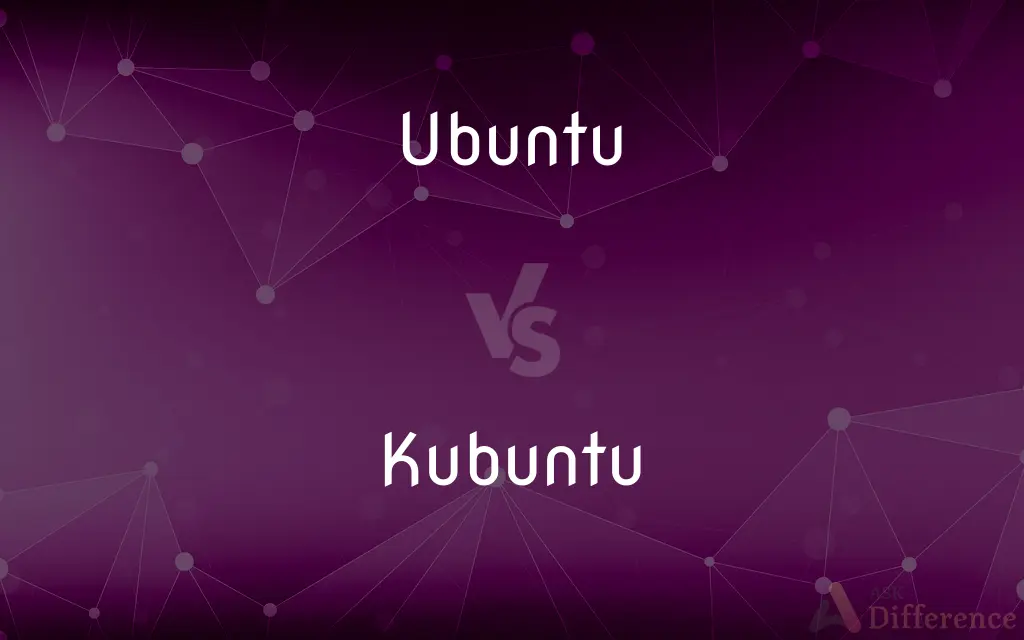Ubuntu vs. Kubuntu — What's the Difference?
By Maham Liaqat & Fiza Rafique — Updated on March 24, 2024
Ubuntu uses GNOME as its default desktop environment, focusing on simplicity and security, while Kubuntu employs KDE, known for customization and a Windows-like experience.

Difference Between Ubuntu and Kubuntu
Table of Contents
ADVERTISEMENT
Key Differences
Ubuntu is a popular Linux distribution based on Debian, known for its stability, security, and user-friendly experience. It uses the GNOME desktop environment by default, which is designed to be simple and efficient, with a focus on ease of use and accessibility. GNOME's interface is streamlined and minimalist, aiming to provide a clean and straightforward user experience. On the other hand, Kubuntu is an official variant of Ubuntu that uses the KDE Plasma desktop environment. KDE is celebrated for its high degree of customization, offering a more feature-rich and visually appealing interface that can be tailored extensively to suit personal preferences. KDE Plasma is often compared to Windows in terms of its layout, making it an attractive choice for users transitioning from Windows to Linux.
While Ubuntu prioritizes a unified and consistent user experience, with limited options for customization out of the box to maintain simplicity, Kubuntu offers a plethora of customization options, from themes and widgets to application styles and desktop effects. This makes Kubuntu a preferred choice for users who enjoy tailoring their computing environment to their exact specifications. Both Ubuntu and Kubuntu share the same core system and repositories, ensuring access to the same wide range of applications and updates. This means that regardless of the desktop environment, users can expect the same level of performance, security, and software availability.
Ubuntu's GNOME desktop environment is known for its focus on productivity and efficiency, offering features like Activities Overview and virtual desktops in a manner that's both powerful and easy to navigate for new users. Kubuntu's KDE, however, provides a more traditional desktop model, with a familiar menu-driven interface and a wealth of options for window management and desktop effects, appealing to users who prefer a more conventional or detailed approach to desktop interaction.
Both distributions are supported by a vast community and have access to extensive documentation, making it easy for users to find help and support. Ubuntu's community is larger due to its longer history and broader appeal, but Kubuntu's community is highly dedicated, particularly to KDE development and customization. This ensures that both new and experienced users can find resources, tutorials, and support tailored to their specific needs and preferences.
Despite their differences, Ubuntu and Kubuntu are not in competition but rather serve different user preferences within the Ubuntu ecosystem. Choosing between them comes down to personal preference regarding the desktop environment and the user experience one seeks from a Linux distribution. Users can even switch between GNOME and KDE on the same installation, offering the flexibility to explore both environments without committing to a single distribution.
ADVERTISEMENT
Comparison Chart
Desktop Environment
GNOME (simple and efficient)
KDE Plasma (customizable and feature-rich)
User Experience
Streamlined and minimalist, focusing on simplicity and accessibility
Highly customizable with a Windows-like interface
Customization
Limited out of the box to maintain simplicity
Extensive, with options for themes, widgets, and desktop effects
Focus
Productivity and efficiency
Personalization and visual appeal
Community
Larger and broader, with extensive support and documentation
Dedicated, particularly to KDE customization and development
Compare with Definitions
Ubuntu
A Linux distribution based on Debian, using GNOME as its default desktop environment.
Ubuntu is widely recognized for its user-friendly interface and strong community support.
Kubuntu
An official variant of Ubuntu that uses the KDE Plasma desktop environment for a customizable experience.
Kubuntu allows users to easily modify the look and feel of their desktop to match their preferences.
Ubuntu
Offers a clean and straightforward user experience with minimalistic design principles.
Ubuntu’s GNOME desktop environment avoids clutter and focuses on a clean and efficient workspace.
Kubuntu
Focuses on providing a feature-rich user experience without compromising on performance.
Despite its visual appeal and customization features, Kubuntu maintains a balance between aesthetics and efficiency.
Ubuntu
Prioritizes security and simplicity, offering a streamlined computing experience.
Ubuntu comes with essential applications pre-installed, making it ready for use right after installation.
Kubuntu
Supported by a dedicated community passionate about KDE development and customization.
Kubuntu’s community contributes to a wide range of KDE applications and customization options available to users.
Ubuntu
Emphasizes ease of use and accessibility for beginners.
Ubuntu includes features like the Ubuntu Software Center, making application management accessible to all users.
Kubuntu
Features a Windows-like interface, making it a comfortable choice for users transitioning from Windows.
Kubuntu’s KDE Plasma desktop has a familiar start menu and taskbar, easing the switch for Windows users.
Ubuntu
Known for its stability and reliability in both personal and professional use.
Many businesses choose Ubuntu for its long-term support (LTS) versions, providing updates for up to five years.
Kubuntu
Offers extensive personalization options, from window behavior to desktop themes and widgets.
Kubuntu users can choose from numerous themes and widgets to create a unique computing environment.
Ubuntu
Ubuntu ( (listen) uu-BUUN-too) is a Linux distribution based on Debian and composed mostly of free and open-source software. Ubuntu is officially released in three editions: Desktop, Server, and Core for Internet of things devices and robots.
Kubuntu
Kubuntu ( kuu-BUUN-too) is an official flavor of the Ubuntu operating system that uses the KDE Plasma Desktop instead of the GNOME desktop environment. As part of the Ubuntu project, Kubuntu uses the same underlying systems.
Ubuntu
A philosophical doctrine or approach to life that emphasizes social unity and generosity of spirit.
Ubuntu
(South Africa) A Nguni Bantu ideology focusing on people's allegiances and relations with each other.
Common Curiosities
Is Kubuntu as secure as Ubuntu?
Yes, Kubuntu shares the same core system as Ubuntu, ensuring the same level of security and stability.
Can I install KDE on Ubuntu?
Yes, you can install KDE on Ubuntu, allowing you to switch between GNOME and KDE environments.
Can I use Ubuntu software on Kubuntu?
Yes, both distributions use the same repositories, making software available on one also available on the other.
Do Ubuntu and Kubuntu receive updates at the same time?
Yes, being part of the same family, they receive updates and new releases simultaneously.
Which is better for beginners, Ubuntu or Kubuntu?
Both are user-friendly, but Ubuntu’s GNOME environment is often recommended for its simplicity and ease of use for beginners.
What is the main difference between Ubuntu and Kubuntu?
The main difference lies in their desktop environments: Ubuntu uses GNOME, focusing on simplicity, while Kubuntu uses KDE, known for customization.
Is Kubuntu more resource-intensive than Ubuntu?
Historically, KDE was more resource-intensive, but recent versions of KDE Plasma are optimized for efficiency, making the difference minimal.
Can I switch from Kubuntu to Ubuntu without reinstalling the entire OS?
Yes, you can switch by installing the respective desktop environment packages without reinstalling the OS.
Which distribution is better for professional use?
Both can be used professionally; the choice depends on personal preference and specific use cases.
How does community support compare between Ubuntu and Kubuntu?
Ubuntu has a larger community and broader support, but Kubuntu’s community is very dedicated, especially to KDE development.
Which has better customization options, Ubuntu or Kubuntu?
Kubuntu offers more extensive customization options through KDE Plasma.
Share Your Discovery

Previous Comparison
Earnestly vs. Sincerely
Next Comparison
Art vs. CultureAuthor Spotlight
Written by
Maham LiaqatCo-written by
Fiza RafiqueFiza Rafique is a skilled content writer at AskDifference.com, where she meticulously refines and enhances written pieces. Drawing from her vast editorial expertise, Fiza ensures clarity, accuracy, and precision in every article. Passionate about language, she continually seeks to elevate the quality of content for readers worldwide.
















































